Attachments
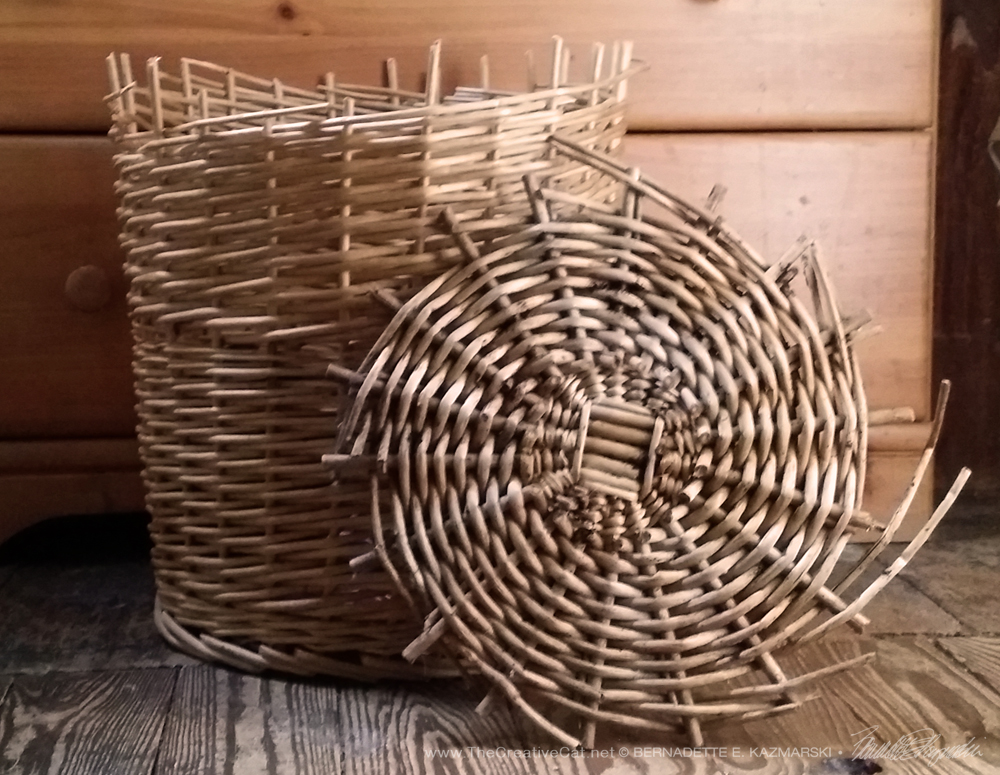
So what’s with the wicker basket and lid that looks as if something chewed around the edges?
That’s just the point. Something did chew around the edges of the lid and the top of the basket. That thing was Kelly. And every time I look at this basket and the lid that can’t be used anymore because it only falls into the basket and I think I should replace the whole thing, I think of Kelly and smile. And I keep the basket.
When Kelly first began circulating around the house in 1997, very shy and cautious, she had a few interesting habits that helped her release her tension at being in a place where she didn’t feel entirely safe. Kelly wasn’t feral, unless ferals had suddenly learned to meow stories to people, but she had a very hard time living with people and yet she accepted it because, though she felt vulnerable, it also had its benefits for her. And because Namir told her to accept it, and he was always there for her. She never acted aggressive or became a passive target with other cats, she never misused the litterbox or scratched anything but things cats were supposed to scratch, she never acted out or lashed out at people. She chewed the basket and its lid.
I had purchased the basket when I moved in here to use as a hamper on the floor next to the pedestal sink in the bathroom. Kelly would join us in the bathroom in the morning before breakfast, and just to keep her cool with so much happening around her she would eagerly dig her teeth into the edge of the lid as if it was a big cookie and bite down with enormously powerful feline jaws, bending and then breaking the decorative weave around the edge, then the woven strands inside that edge. After a few years the lid had no edge and couldn’t be used with the basket so I put it aside. Then Kelly started on the top edge of the basket. It’s about two inches shorter than when it started out.
I would gently ask Kelly to please not do that each time I saw her chewing on the basket and sometimes move it away from her, and she would stop and look at me as if she thought she hadn’t heard me properly, then go back to biting the basket. I knew the only way I’d get her to stop was to remove the basket. I never remembered to buy anything to put in its place, and when I thought about it I wondered what Kelly might do to help her work off her anxiety in a situation that happened every day.
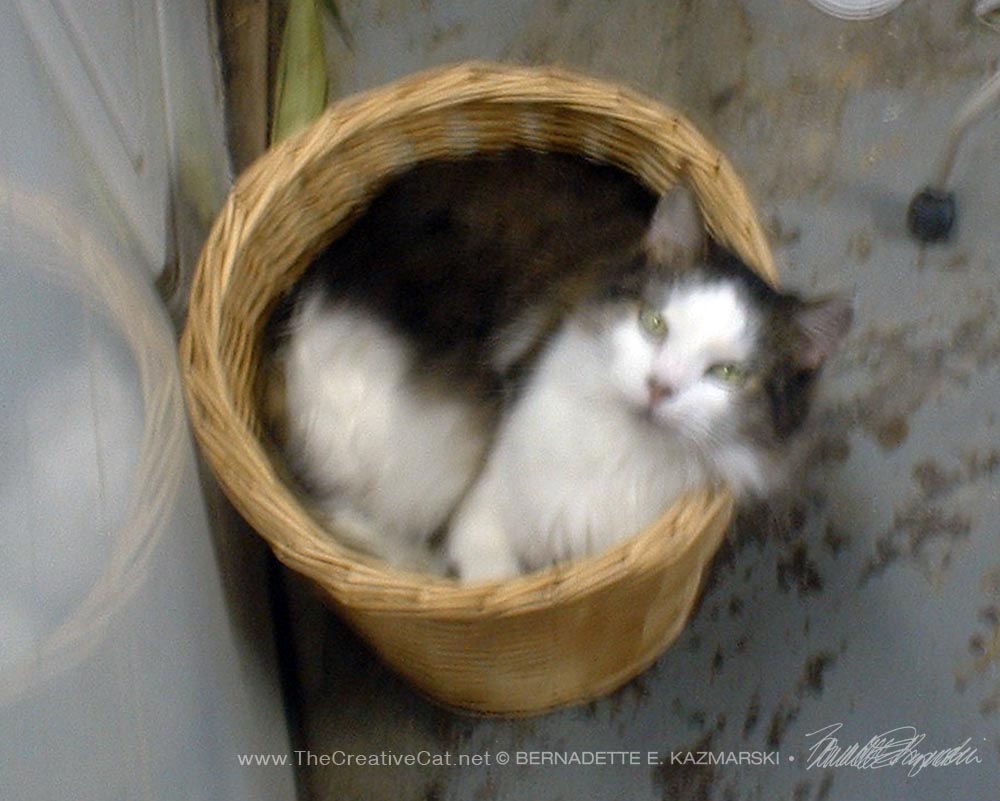
In addition to Kelly customizing it I also remember Cookie and Sophie sleeping inside of it. I remember it being in the bathroom when each of the cats were rescues and then fosters, and when they were ill. A lot of memories are tied up in that basket. And I keep it because I want to continue to be triggered to remember all the things that are tied up in that basket.
That is the nature of attachments. The basket itself isn’t so important that I’d try to stop Kelly from wearing it away or move it to protect it from her, but the memories it holds are. Because I feel the edges are now unsafe I don’t actually have it out unless I’m actively doing laundry, but I keep it stored safely in the cabinet in the bathroom. I will probably use it past any reasonable usefulness then put it aside and keep it for a while longer, then one day pick up all the pieces of it that are left and put them in the trash. Or maybe I’ll keep them.
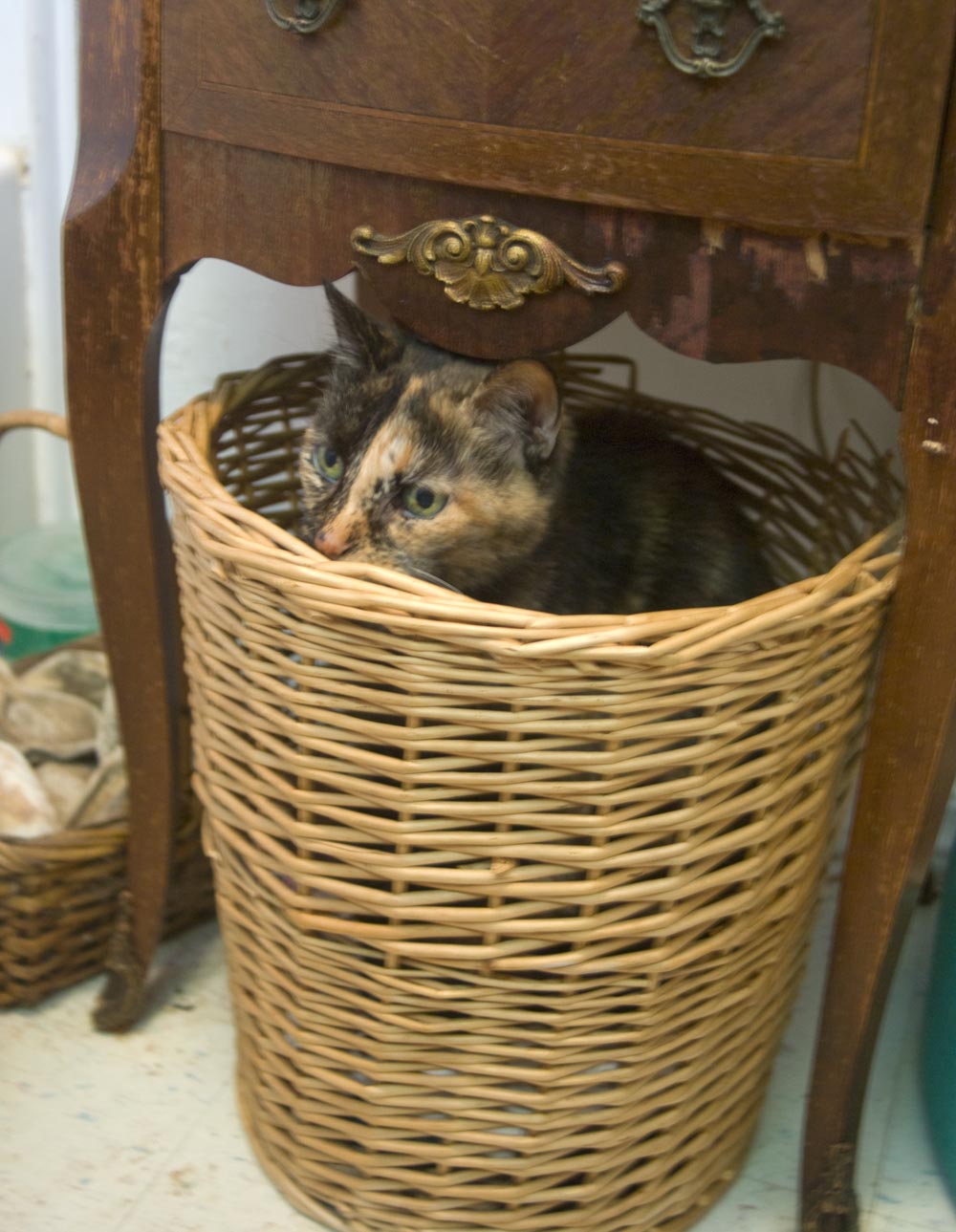
In February 2013, a year after I lost Cookie and had lost Kelly in the same year, bringing a long era in my life to an end in many ways, I broke the ceramic water bowl in the kitchen I had long associated with my feline family, and wrote the first iteration of this idea of attachments. The bowl had been a large, heavy stonewear bowl intended for dogs that had stood solidly with lots of activity in the room and cats who liked to play in the water. Dropping a cast iron pan onto it destroyed it, so sudden and cataclysmic it felt like a physical break even to me—the kitchen is a native place for me, and dropping and breaking things is rare and usually the result of being distracted by thoughts and not focusing on my task. I understood that holding onto the memories of all those cats who had been my feline family was interfering with building new memories with this new family, Mimi and her four children, in their own right, without their ties to their mentors. It wasn’t a betrayal to move forward and simply love this family as I had loved all the others. But without breaking the water bowl, and picking up the pieces and tossing them in the trash, I would not have moved forward.
What is the nature of these attachments, which we don’t often notice until the tangled relationship is threatened or broken, literally or metaphorically? We don’t often realize all the emotional connections we make with the things we perceive during either just a brief moment that settles forever in memory, or a lengthy period of time and all that happens during that time. What we remember is constituted from what we see, hear, smell, touch and taste through our own emotional and intellectual filters, and while we might remember the sound of water filling the ceramic bowl, we don’t remember a thing about the season of the year and how that influenced our clothing and surroundings.
It is an interesting part of our nature as humans to form attachments to things in this way. A few years ago, spending time in Carnegie Antiques with Cookie while I had my shop room there, I looked at a collection of things that the owner, Judi, had set on a chair behind the counter to be sorted and tagged and placed somewhere in the shop: several beaded necklaces in styles from various eras in the past century, a delicate handkerchief edged with lover’s knot lace, an authentic pillow ticking pillow case. Each of these things was in perfect condition, but I wondered why each had survived the generations and their changes and still been kept as possessions. Perhaps they had simply been stored away and not used, but more than likely there had been some reason or intent to keep them, possibly they were even cherished and stored away, for sentimental reasons. I considered the items and the ideas, thought about the things I had carefully protected among my possessions for the memories they held, and wrote a poem about it, Vintage.
We remember what is important to us in that moment, but while visual memories are easiest to place and are usually our most obvious memories, we sense other things in that moment as well, and don’t even realize it. Later, we may hear the water filling the bowl, feel the mild September afternoon breeze on our cheek, smell the soup we made as we set it on the table, and it all comes back to us, even decades later, all the precious details of a common everyday moment for some reason stored away, or a joyous or painful moment, ready to unfold as our conscious mind rebuilds the connections with each of the sensory, intellectual and emotional details.
Too many of these attachments, surrounded by things which hold memories, can interfere with being in this moment and creating new memories, and to excess can be dangerous, often considered hoarding. But a few items that carry us back to a time we find a reason to remember, good or bad, well-kept and protected, or well-loved and battered like The Velveteen Rabbit, give us perspective on our life as it moves forward each day; they are markers for where we have been. Only we may understand the reason why a chewed up old dollar-store wicker laundry basket is still in use, but in that moment we are the only ones who need to know.
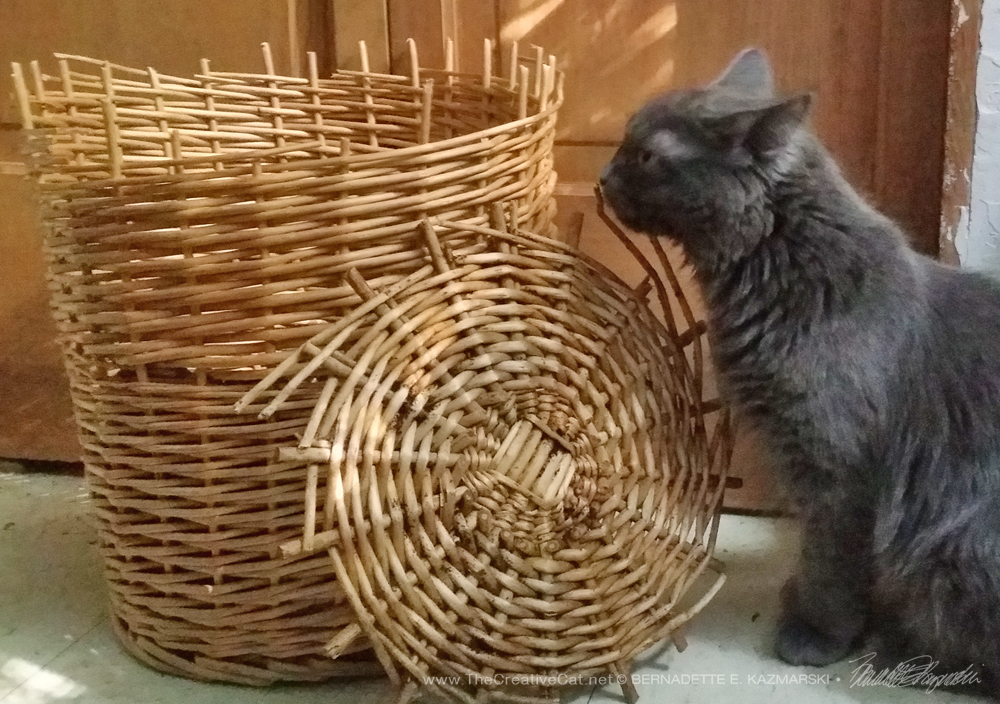
Are these emotional attachments bad? If they inhibit you from growing, you need to let go of them, like the water bowl. That doesn’t mean you need to do it all at once or without ceremony. I’ve learned to be gentle with myself in this area after only hurting myself a few times, feeling disrespectful to a memory, or not yet done processing my feelings. Acknowledge them, bring them out into the light, learn from what they have to give you, then let them go when you are done with them.
My relationship with items is something I’ve always needed to manage, and aside from my collection of feline-themed items, most of which are cherished gifts and many of which have been creative inspirations for my own work, I don’t collect anything. But I try to keep everything, and I question my need to bring something into my life or keep something that’s not useful in daily life or in my business or creative efforts each time the situation arises. Things like the basket, which is still useful and also carries a lot of memories, I allow myself, along with a few other items here and there.
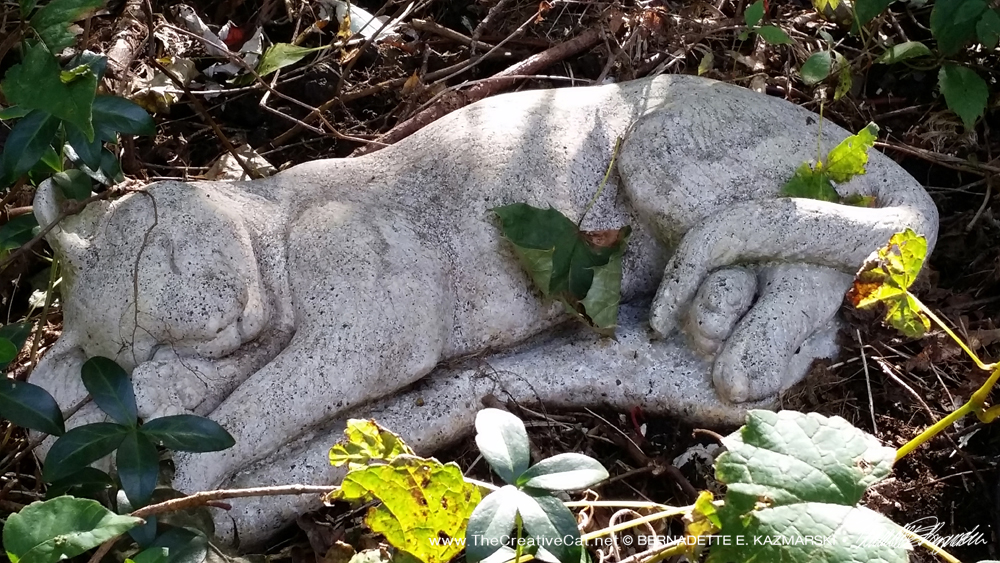
My musing about this at this time probably has to do with the approach of my 25th anniversary in this house, October 19, and realizing I’ve spent nearly half my life here. Of course, I’ve done most of my rescuing and fostering here as well and this house and all that’s in it, and especially the bathroom itself, hold the memories of over 100 cats and kittens who spent some amount of time here, births and deaths, building lasting trust, healing injuries and illnesses, providing long-term palliative care.
Autumn is a natural time of review for me too, beginning in August when I can feel the summer slipping to fall; it’s been part of the cycle of my own life for as long as I can remember. As Mimi and I wander our little habitat and I see the light slowly changing and the color palette filling with yellows and misty blues I remember the many feline comings and goings which have happened in autumn too. Stanley showed up on my porch in October, and stayed until I took him in in November. I lost Kublai on September 19 and Allegro on October 3, Kelly and Namir arrived on October 3 the following year. Sally mysteriously stopped eating in late September and Fawn was diagnosed with lymphoma in November the same year; Sally’s osteosarcoma was found the following January. I brought Moses home in late September, and 20 years later she began a quick, brief decline in September after her last good summer. Sophie, my housewarming cat, came home on November 1 just after I’d moved in here; years later she struggled with what seemed to be an allergy but which in late October seemed to be more likely a mass in her throat. Peaches died October 20. Those are in no particular order, and they are by no means the only ones, but they are my memories as autumn approaches and I look at my year, and my years.
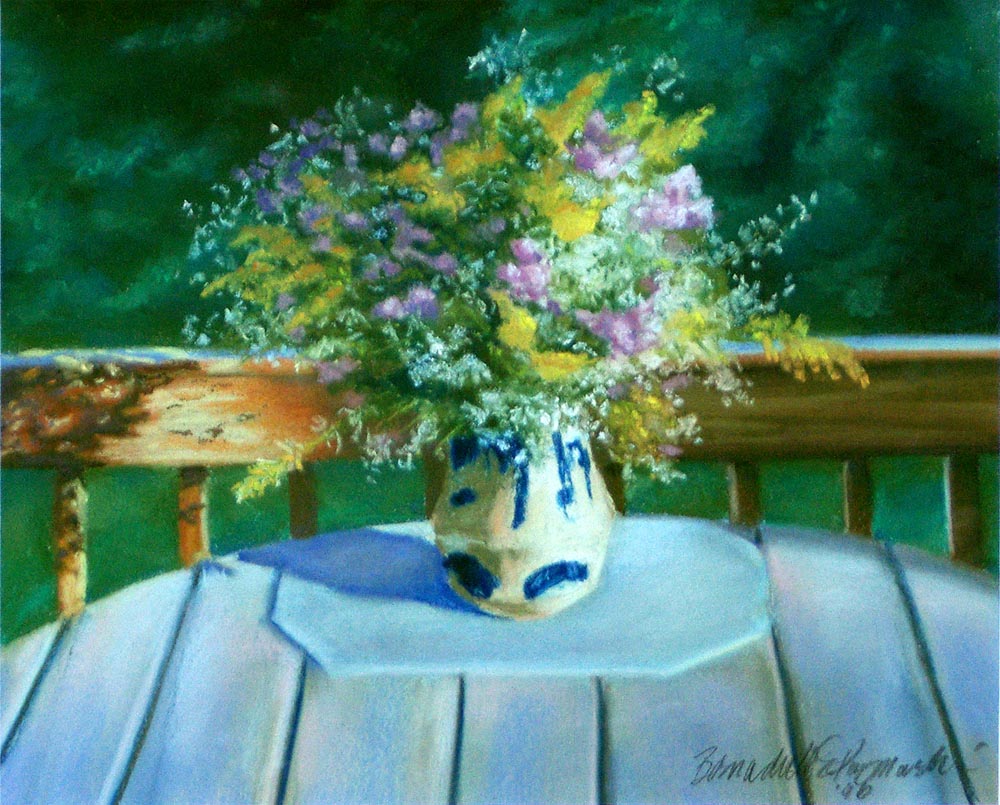
Read more Essays on The Creative Cat.
All images used on this site are copyrighted to Bernadette E. Kazmarski unless otherwise noted and may not be used without my written permission. Please ask if you are interested in using one in a print or internet publication. If you are interested in purchasing a print of this image or a product including this image, check my Etsy shop or Fine Art America profile to see if I have it available already. If you don’t find it there, visit Ordering Custom Artwork for more information on a custom greeting card, print or other item.




This is beautiful indeed!
Memories can be powerful and worthy of respect.
I have also kept my fine share of things along the way… I should get rid of some of them and I have to be careful with the memories attached.
Beautiful post!
Thank you! It’s all I can do not to keep a house full of things just like I have a house full of cats.